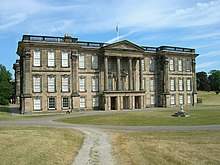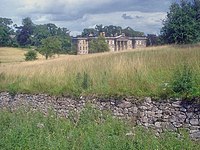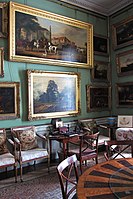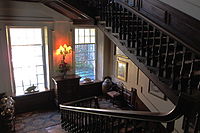Calke Abbey
Calke Abbey is a country house near Ticknall in the English county of Derbyshire . Listed by English Heritage as a Grade I Historic Building, the property is managed by a nonprofit National Trust .
The site was an Augustinian priory from the 12th century until it was dissolved by King Henry VIII . The current building, which has been called Calke Abbey since 1808, was actually never an abbey , but rather a baroque mansion that was built between 1701 and 1704.
The house belonged to the Harpur family for nearly 300 years until 1985 when it was given to the National Trust for inheritance tax relief . Today the house is open to the public and many rooms have been preserved in the state in which they were given to the National Trust.
history

The Calke Priory was founded by Richard d'Avranches, 2nd Earl of Chester sometime between 1115 and 1120 and consecrated to St. Giles . D'Avranches had inherited extensive lands in England and Normandy from his father , which included Calke and many of the surrounding villages.
Calke Priory was initially an independent parish, but after Ranulph de Gernon's death in 1153 it fell (along with most of his other Derbyshire lands) to his widow, Maud of Gloucester . Maud initially donated the nearby church of St. Wystan in Repton to the priests of the Calke Priory, but then had a new priory built in Repton, which was dedicated to the Holy Trinity. In 1172 she had the priests resettled from Calke to Repton and Calke became the subordinate "cell" of the Repton priory.
Nothing is known about the role of the priory in the 14th and 15th centuries, but historian Oliver Garnett believes that it served as the center of an agricultural estate at that time, rather than a religious establishment.
The Repton Priory was dissolved in 1538 and its land was confiscated by the Crown. However, the priests had foreseen the liquidation and began to lease their lands: Calke was one of them and it was leased to John Perst (or John Priest ) on August 29, 1537 for 99 years .
After the monasteries were dissolved
John Perst leased the Calke Priory for 99 years, having paid the lease for 59 years in advance. He was a member of the London Grocers Company and lived in Calke until his death in 1546. The house then fell to his widow, later to his daughter Frances and her husband William Bradborne . The Crown then gave the lease to John Dudley, Earl of Warwick , later Duke of Northumberland, after which the property fell to various owners and tenants before Richard Wendsley bought it in 1575. Wendsley was twice a Member of Parliament for Derbyshire and built a new house on the estate where he lived; this is the Elizabethan style house , the centerpiece of the house that still exists today. Parts of it can still be seen in the courtyard today. Little was known about this Elizabethan house until the National Trust renovation of the present house in 1988. The house was built around a courtyard, with the south wing serving as an entrance front with a gatehouse. Two investigations of the foundations in the northeast and northwest revealed the location of the two stair turrets. The work also unearthed a later round arched loggia from the 17th century, which was located next to the two stair turrets. The east and west wings of the house were not parallel, which significantly influenced the shape and layout of the current house. This discrepancy could either be a result of the various stages of construction in the Elizabethan house or the layout and orientation of the priory's original buildings.
In 1585 Wendsley sold the property to three-time MP for Derby, Robert Bainbridge . He was an "extreme Protestant" who was imprisoned in the Beauchamp Tower of the Tower of London in 1586 because of his refusal to recognize the church resolutions of Elizabeth I (where he carved his name, which can still be seen there today). Historian Oliver Garnett thinks that Bainbridge wanted to live in Calke because the church there was not under the control of the bishop, which meant that he could pursue his Puritan faith there undisturbed. After Bainbridge's death, Calke fell to his son, who was also named Robert. This Robert Bainbridge sold the property to Sir Henry Harpur in 1622 for £ 5,350.
The Harpurs
In 1622 Sir Henry Harpur, 1st Baronet , (approx. 1579–1639) bought the property. The Harpur family was established in the mid-16th century. They were descendants of Richard Harpur , a successful attorney who was promoted to judge on the Court of Common Pleas at Westminster and then presiding judge of the County Palatine of Lancaster . He and his descendants acquired lands in Staffordshire (around Alstonfield ) and Derbyshire (around Swarkestone ) through their wealth and skillful marriage policies .
The house was rebuilt from 1701 to 1704 by Sir John Harpur, 4th Baronet , (1680–1741). The house and property then passed into the hands of the following Baronets Harpur and finally they were inherited by Sir Vauncey Harpur-Crewe, 10th Baronet , (1846-1924), who dealt with the collection of natural history pieces. After his death, his eldest daughter, Hilda Harpur-Crewe (1877–1949) sold some of his collection of birds, butterflies and fish in order to be able to pay inheritance tax. She was followed by her nephew, Charles Jenney (1917-1981), the eldest son of Frances Harpur-Crewe , the fourth daughter of Sir Vauncey. Charles renamed himself Charles Harpur-Crewe . His sudden death led to ruinous inheritance taxes (£ 8 million on a £ 14 million property) and the property was transferred to the National Trust in 1985 by his younger brother Henry Harpur-Crewe (1921-1991).
today
The house in the middle of a landscaped garden is now presented by the National Trust as an example of an English country house in decline. Extensive maintenance work was carried out, but no renovations were made, and the interiors largely remained in the condition in which they were found in 1985, so that the decline of the building and interior was halted but not reversed. Before the work done by the National Trust in the late 1980s, everything had been untouched since the 1880s.
On the side of the house is a large square of buildings from the old stable yard and the farm, fully equipped with old carts and agricultural implements. The outbuildings also include a brewhouse , which was connected to the main building by a tunnel.
The National Trust manages the surrounding landscape park under conservation aspects. It contains z. B. an enclosed garden with a flower garden and a former medical garden, which is now operated as a kitchen garden. The old deer park of Calke Abbey is designated as a Site of Special Scientific Interest and National Nature Reserve , which is best known for its rare hat forest and the associated dead wood fauna.
Several years after Calke Abbey was turned over to the National Trust to pay inheritance taxes, another heir was discovered: Andrew Johnson , a distant relative of the Harpur family. Johnson was a wealthy Vermont American and owner of extensive forests and a timber business that the British tabloids referred to as "Lumberjack". Johnson was given an apartment in Calke Abbey, which he and his family use on occasional visits to England.
The limestone quarries on the estate at Ticknall are the terminus of the Ticknall Tramway , which transported limestone to the Ashby Canal in the Willesley Basin . This railway line was abandoned in 1915, but one of the tunnels was renovated and still runs under the driveway today.
Gallery images
Ha-ha from Calke Abbey
Individual evidence
- ↑ Calke Abbey . English Heritage ( Page no longer available , search in web archives ) Info: The link was automatically marked as defective. Please check the link according to the instructions and then remove this notice. . Retrieved February 26, 2015.
- ^ Images of England, architectural description . Imagesofengland.org.uk. Archived from the original on January 21, 2015. Info: The archive link was automatically inserted and has not yet been checked. Please check the original and archive link according to the instructions and then remove this notice. Retrieved February 26, 2015.
- ↑ a b c d e f g h i j k l m n o p q r s t u v w Oliver Garnett: Calke Abbey: The National Trust Guidebook . The National Trust, 2000.
- ^ SSSI citation: Calke Park . Natural England. Retrieved February 26, 2015.
- ↑ Calke Park NNR . Natural England. Retrieved February 26, 2015.
- ↑ www.madriverweb.com: A Johnson Co, LLC, Forestry . Vermontlumber.com. Retrieved February 26, 2015.
- ↑ z. B. Daily Mail and Daily Mirror dated May 7, 1999.
Web links
Coordinates: 52 ° 47'59 " N , 1 ° 27'21" W.
















